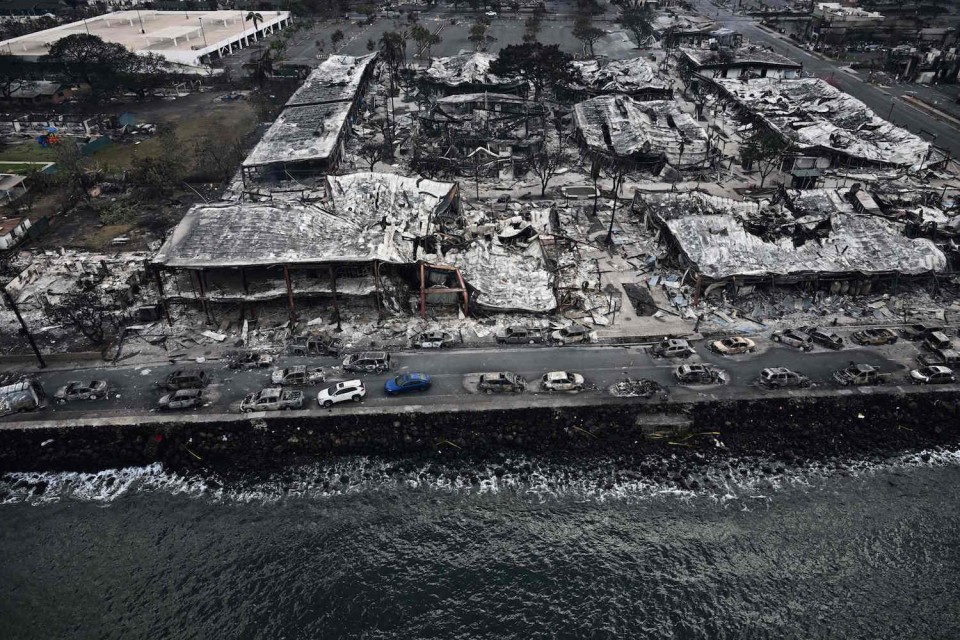KAHULUI, United States, Aug 11, 2023 (AFP) – The death toll from a terrifying wildfire that razed a historic Hawaiian town hit 53 Thursday, making it one of the deadliest disasters to strike the islands since they became a US state.
Brushfires on the west coast of Hawaii’s Maui island — fueled by high winds from a nearby hurricane — broke out Tuesday and rapidly engulfed the seaside town of Lahaina.
The flames moved so quickly that many were caught off-guard, trapped in the streets or jumping into the ocean in a desperate bid to escape.
“In 1960 we had 61 fatalities when a large wave came through Big Island,” Governor Josh Green said, referring to a tragedy that struck a year after Hawaii became the 50th US state.
“This time, it’s very likely that our death totals will significantly exceed that.”
Officials in Maui County said Thursday the confirmed number of dead now stood at 53, and firefighters were still battling the blaze.
Lahaina on Thursday lay in charred, smoking ruins, with Green saying 80 percent of the town was gone.
“There is no doubt everyone would describe this as though a bomb hit Lahaina,” he said. “It looks like total devastation; buildings that we’ve all enjoyed and celebrated together for decades, for generations, are completely destroyed.”
President Joe Biden on Thursday declared the fires a “major disaster” and unblocked federal aid for relief efforts, as residents said they needed more help in a recovery that could take years.

– Bodies –
US Coast Guard commander Aja Kirksey told CNN around 100 people were believed to have jumped into the water in a desperate effort to flee the fast-moving flames as they tore through Lahaina.
Kirksey said helicopter pilots struggled to see because of the dense smoke pouring from the huge fire, but that a Coast Guard vessel had been able to rescue more than 50 people from the water.
“It was a really rapidly developing scene and pretty harrowing for the victims that had to jump into the water,” she added.
For resident Kekoa Lansford, the horror was far from over.
“We still get dead bodies in the water floating and on the seawall,” Lansford told CBS.
“We have been pulling people out… We’re trying to save people’s lives, and I feel like we are not getting the help we need.”
Aerial photographs of Lahaina, which served as the Hawaiian kingdom’s capital in the early 19th century, showed entire blocks reduced to cinders.
Green said around 1,700 buildings were now believed to have been affected by the blaze.
“With lives lost and properties decimated, we are grieving with each other during this inconsolable time,” Maui Mayor Richard Bissen said.
“In the days ahead, we will be stronger as a… community,” he added, “as we rebuild with resilience and aloha.”
– Evacuations –
Thousands of people have already been evacuated from Maui, with 1,400 people waiting at the main airport in Kahului overnight, hoping to get out.
Maui County has asked visitors to leave “as soon as possible,” and has organized buses to move evacuees from shelters to the airport.
The island hosts around a third of all the visitors who holiday in the state, and their dollars are vital for the local economy.
Fires have also broken out on Hawaii’s Big Island, but officials said they were under control on Thursday.
The state’s tourism chief Jimmy Tokioka acknowledged the tragedy but reiterated that the “rest of Hawaii is open.”
With a hurricane passing to the south of Hawaii, high winds fueled flames that consumed dry vegetation.
Thomas Smith, a professor with the London School of Economics, said that while wildfires are not uncommon in Hawaii, the blazes this year “are burning a greater area than usual, and the fire behavior is extreme, with fast spread rates and large flames.”
The Hawaii fires follow other extreme weather events this summer in North America, with record-breaking wildfires still burning across Canada and a major heat wave baking the US southwest.
Europe and parts of Asia have also endured soaring temperatures, with major fires and floods wreaking havoc.
As global temperatures rise over time, heat waves are projected to become more frequent, with increased dryness due to changing rainfall patterns creating ideal conditions for bush or forest fires.








